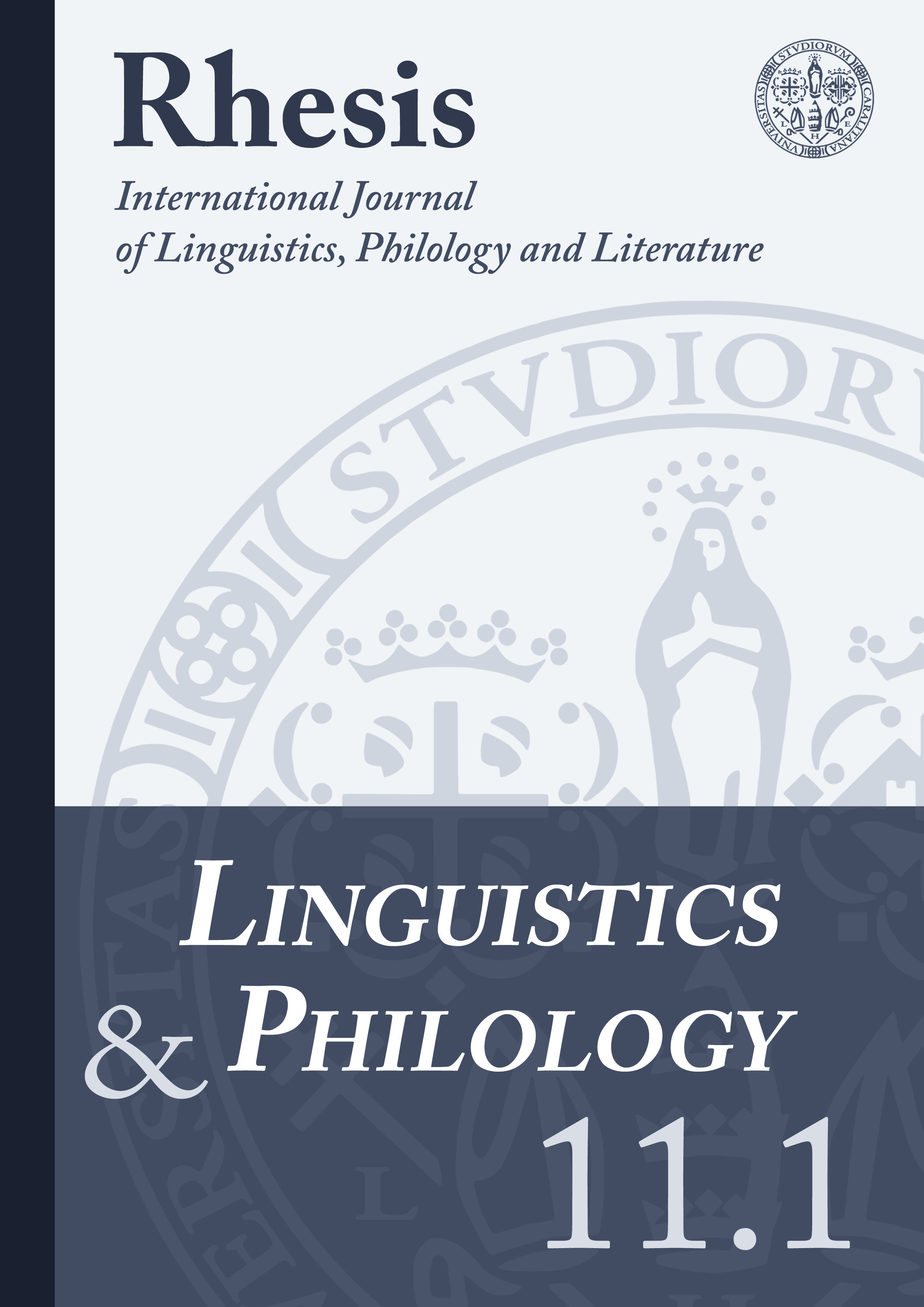La figura di Cassandra sulla scena tragica di V secolo: le testimonianze dell’Agamennone e delle Troiane
Abstract
In both Aeschylus’ Agamemnon and Euripides’ Trojan Women, Cassandra plays the role of tragic heroine, subjected to Apollo’s manipulation, aware of the past and the present of the house of Atreus and able to predict the future; but on stage the people she speaks with do not seem to understand her predictions and are not persuaded by her words. The aim of the paper is to focus on the main features of the tragic character of Cassandra in Aeschylus and Euripides and to investigate the levels of manipulation and communication.
Downloads
References
Bannert, Herbert (1994), ‘Beobachtungen zu den Troerinnen des Euripides’, Wiener Studien 107, 197-220.
Bernabé, Albert (19962) [1987], Poetarum Epicorum Graecorum. Testimonia et Fragmenta. Pars I, Leipzig, B. G. Teubneri.
Bettini, Maurizio (2018) [2008], Voci: antropologia sonora del mondo antico, Roma, Carocci.
Brault, Pascale-Anne (2009), ‘Playing the Cassandra: Prophecies of the Feminine in the Polis and Beyond’, in McCoskey, Denise E; Zakin, Emily (eds.), Bound by the City: Greek Tragedy, Sexual Difference, and the Formation of the Polis, Albany, State University of New York Press, 197-220.
Brillet-Dubois, Pascale (2015), ‘A Competition of choregoi in Euripides’ Trojan Women. Dramatic Structure and Intertextuality’, Lexis 33, 168-180.
Cerbo, Ester (2009), ‘La monodia di Cassandra (Eur. Troad. 308-340) fra testo e scena’, Quaderni Urbinati di Cultura Classica 93 (3), 85-96.
Conacher, Desmond J. (1983), ‘The Trojan Women’, in Segal, Erich (ed.), Oxford Readings in Greek Tragedy, Oxford, Oxford University Press, 332-339.
Crippa, Sabina (1990), ‘Glossolalia. Il linguaggio di Cassandra’, Studi italiani di linguistica teorica ed applicata 19 (3), 487-508.
Davreux, Juliette (1942), La légende de la prophétesse Cassandre d’après les textes et les monuments, Liége-Paris, Dorz.
Dell’Anno, Valentina (2015), ‘La rondine Cassandra. Il linguaggio degli uccelli nella divinazione antica’, in Carboni, Romina; Giuman, Marco (eds.), Sonora: la dimensione acustica nel mondo mitico, magico e religioso dell’antichità classica, Perugia, Morlacchi, 39-49.
Detienne, Marcel (1977), I maestri di verità nella Grecia arcaica, Roma-Bari, Laterza (Les Maîtres de vérité dans la Grèce archaïque, Paris, François Maspero, 1967).
Euben, J. Peter (1982), ‘Justice and the Oresteia’, The American Political Science Review 76 (1), 22-33.
Feichtinger, Barbara (1991), ‘Zur Kassandra-Szene in Aischylos’ Orestie und ihren poetischen Funktionen’, Würzburger Jahrbücher für Altertumswissenschaft 17, 49-67.
Goff, Barbara (2009), Euripides: Trojan Women, London, Duckworth.
Hall, Edith (2004) [1989], Inventing the Barbarian: Greek Self-Definition through Tragedy, Oxford, Clarendon Press.
Harder, Ruth. E. (1993), Die Frauenrollen bei Euripides: Untersuchungen zu Alkestis, Medeia, Hekabe, Erechtheus, Elektra, Troades und Iphigeneia in Aulis, Stuttgart, M&P.
Heirman, Leo Johannes (1975), ‘Kassandra’s Glossolalia’, Mnemosyne 28 (3), 257-267.
Judet de La Combe, Pierre (2001), L’Agamemnon d’Eschyle: commentaire des dialogues, Villeneuve d’Ascq, Presses Universitaires du Septentrion.
Knox, Bernard M. W. (1972), ‘Aeschylus and the Third Actor’, The American Journal of Philology 93 (1), 104-124.
Kovacs, David (2018), Euripides, Troades, Oxford, Oxford University Press.
Leahy, Desmond M. (1969), ‘The Role of Cassandra in the Oresteia of Aeschylus’, Bulletin of the John Rylands Library 52, 144-177.
Loraux, Nicole (2001), La voce addolorata. Saggio sulla tragedia greca, Torino, Einaudi (La voix endeuillée. Essai sur la tragédie grecque, Paris, Gallimard, 1999).
Luschnig, Cecelia A. E. (1971), ‘Euripides’ Trojan Women: All Is Vanity’, The Classical World 65 (1), 8-12.
Mason, P. Geoffrey (1959), ‘Kassandra’, The Journal of Hellenic Studies 79, 80-93.
Mazzoldi, Sabina (2001a), Cassandra, la vergine e l’indovina. Identità di un personaggio da Omero all’Ellenismo, Pisa-Roma, Istituti Editoriali e Poligrafici Internazionali.
Mazzoldi, Sabina (2001b), ‘Lo scotto di Cassandra µάντιϛ: Aesch. Ag. 1275-1276’, Quaderni Urbinati di Cultura Classica 68 (2), 93-98.
Mazzoldi, Sabina (2002), ‘Cassandra’s Prophecy between Ecstasy and Rational Mediation’, Kernos 15, 145-154.
Medda, Enrico (2017), Eschilo. Agamennone, Roma, Bardi.
Murray, Gilbert (1905), Euripidis Fabulae. Tomus 2, insunt Supplices, Hercules, Ion, Troiades, Electra, Iphigenia Taurica, Oxonii, Typographeo Clarendoniano.
Paco Serrano, Diana M. de (2011), ‘Cassandra e le donne tragiche’, Myrtia 26, 123-139,
Papadopoulou, Thalia (2000), ‘Cassandra’s Radiant Vigour and the Ironic Optimism of Euripides’ Troades’, Mnemosyne 53 (5), 513-527.
Pillinger, Emily J. (2019), Cassandra and the Poetics of Prophecy in Greek and Latin Literature, Cambridge, Cambridge University Press.
Schein, Seth L. (1982), ‘The Cassandra Scene in Aeschylus’ Agamemnon’, Greece & Rome 29 (1), 11-16.
Tomasello, Marianna (2012), ‘L’inno delle Erinni e il lamento di Cassandra: canti performativi nell’Orestea di Eschilo’, Quaderni Urbinati di Cultura Classica 101 (2), 63-90.
Wilamowitz-Moellendorff, Ulrich von (1901), Griechische Tragoedien übersetzt. Orestie, Berlin, Weidmannsche Buchhandlung.



